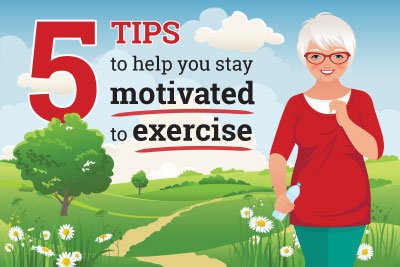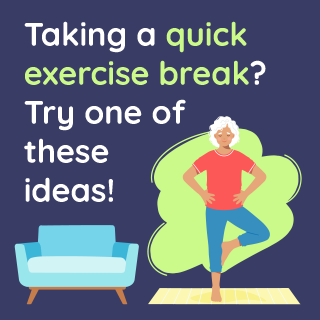How Older Adults Can Get Started With Exercise
On this page:
Deciding to become physically active can be one of the best things you can do for your health. Exercise and physical activity are not only great for your mental and physical health, but they can help keep you independent as you age. Now, let’s talk about getting started.
How much activity do older adults need?
According to the Physical Activity Guidelines for Americans (PDF, 14.5M) you should do at least 150 minutes (2½ hours) a week of moderate-intensity aerobic exercise, like brisk walking or fast dancing. Being active at least three days a week is best, but doing anything is better than doing nothing at all. You should also do muscle-strengthening activities, like lifting weights or doing situps, at least two days a week. The Physical Activity Guidelines also recommend that as part of your weekly physical activity, you combine multiple components of exercises. For example, try balance training as well as aerobic and muscle-strengthening activities. If you prefer vigorous-intensity aerobic activity (like running), aim for at least 75 minutes a week.
How older adults can get started with exercise
Exercise and physical activity are great for your mental and physical health and help keep you independent as you age. Here are a few things you may want to keep in mind when beginning to exercise.
Start slowly when beginning exercise
The key to being successful and safe when beginning a physical activity routine is to build slowly from your current fitness level. Over-exercising can cause injury, which may lead to quitting. A steady rate of progress is the best approach.
To play it safe and reduce your risk of injury:
- Begin your exercise program slowly with low-intensity exercises.
- Warm up before exercising and cool down afterward.
- Pay attention to your surroundings when exercising outdoors.
- Drink water before, during, and after your workout session, even if you don’t feel thirsty. Play catch, kickball, basketball, or soccer.
- Wear appropriate fitness clothes and shoes for your activity.
- If you have specific health conditions, discuss your exercise and physical activity plan with your health care provider.
Download and fill out the Find Your Starting Point Activity Log (PDF, 904K) to document your starting point. You’ll find space to track your normal activity levels for a few days — try to choose a few weekdays and one weekend day.
Don’t forget to test your current fitness level for all four types of exercise — endurance, balance, flexibility, and strength. You may be in shape for running, but if you’re not stretching, you’re not getting the maximum benefit from your exercise. Write down your results so you can track your progress as you continue to exercise.
Make notes about how these test exercises feel. If the exercises were hard, do what’s comfortable and slowly build up. If they were easy, you know your level of fitness is higher. You can be more ambitious and challenge yourself.
Once you start exercising, use the Monthly Progress Test (PDF, 675K) to check in and see how you are improving, and celebrate your successes!
How to set fitness goals

Many people find that having a firm goal in mind motivates them to move ahead on a project. Goals are most useful when they are specific, realistic, and important to you. Be sure to review your goals regularly as you make progress or your priorities change.
Download and use the Goal-Setting Worksheet (PDF, 691K) to document where you want to be in both the short- and long-term.
Write down your short-term fitness goals
Short-term goals will help you make physical activity a regular part of your daily life. For these goals, think about the things you’ll need to get or do in order to be physically active. For example, you may need to buy walking shoes or fill out an Activity Log so you can figure out how to fit physical activity into your busy day. Make sure your short-term goals will really help you be active. Here are a few examples of short-term goals:
- Today, I will decide to be more active.
- Tomorrow, I will find out about exercise classes in my area.
- By the end of this week, I will talk with my friend about exercising with me a couple of times a week.
- In the next two weeks, I will make sure I have the shoes and comfortable clothes I need to start walking for exercise.
Write down your long-term goals
After you write down your short-term goals, you can go on to identify your long-term goals. Focus on where you want to be in six months, a year, or two years from now. Long-term goals also should be realistic, personal, and important to you. Here are a few examples:
- By this time next year, I will swim one mile three times a week.
- Next summer, I will be able to play pitch and catch with my grandchildren.
- In six months, I will have my blood pressure under control by increasing my physical activity and following my doctor’s advice.
Write a plan to add exercise and physical activity to your life
Some people find that writing an exercise and physical activity plan helps them keep their promise to be active, while some people can plunge into a new project without planning ahead. If you choose to make a plan, be sure the plan is realistic for you to do, especially as you gain experience in how to be active. You might even make a contract with a friend or family member to carry out your plan. Involving another person can help you keep your commitment.
Review and update your exercise plan regularly
Regularly review and update your plan and long-term goals so that you can build on your success. Adjust your plan as you progress or if your schedule changes. You may find that things like vacations or illness can interrupt your physical activity routine. Don’t get discouraged! You can start exercising again and be successful. You can use a Weekly Exercise and Physical Activity Plan (PDF, 345K) to write down your activities.
You may also be interested in
- Learning about the right shoes and clothes for exercise
- Monitoring your exercise progress with tracking tools
- Finding tips for staying motivated to exercise
Sign up for e-alerts about healthy aging
For more information about exercise and physical activity
Office of Disease Prevention and Health Promotion (ODPHP)
240-453-8280
odphpinfo@hhs.gov
https://health.gov/
American Council on Exercise
888-825-3636
receptionist@acefitness.org
www.acefitness.org
Centers for Disease Control and Prevention (CDC)
800-232-4636
888-232-6348 (TTY)
cdcinfo@cdc.gov
www.cdc.gov
MedlinePlus
National Library of Medicine
www.medlineplus.gov
This content is provided by the NIH National Institute on Aging (NIA). NIA scientists and other experts review this content to ensure it is accurate and up to date.
Content reviewed:
April 03, 2020



